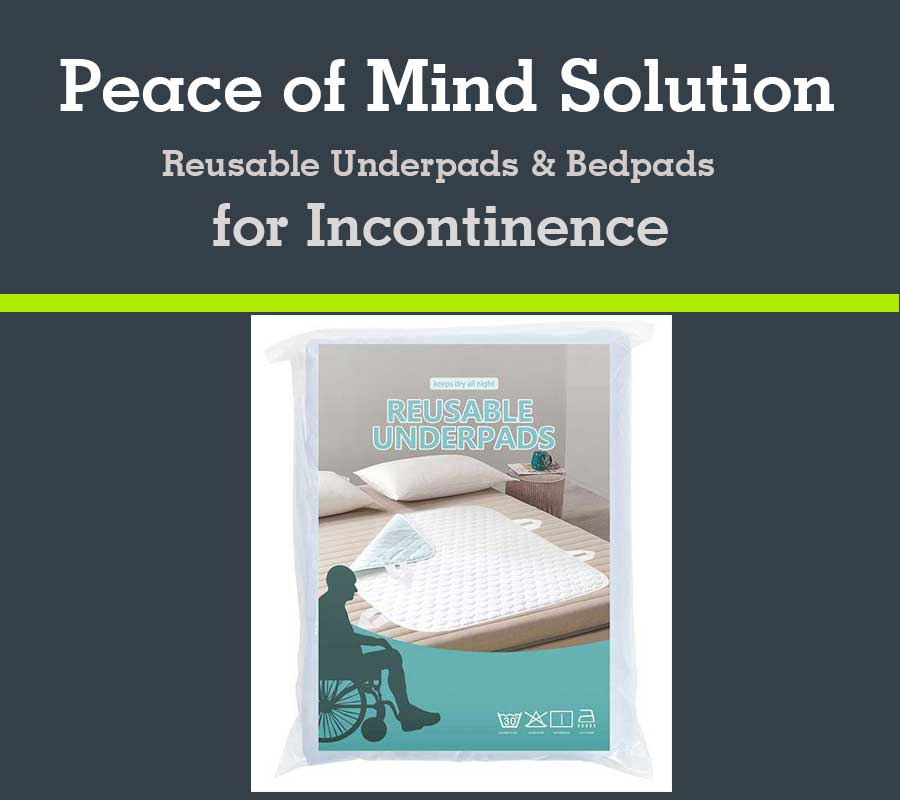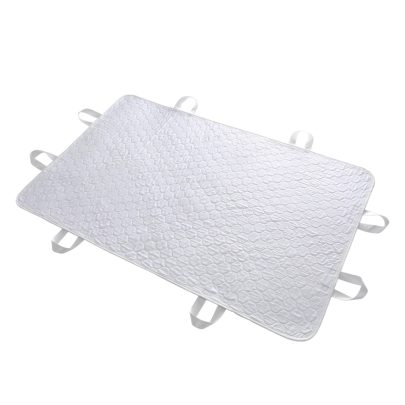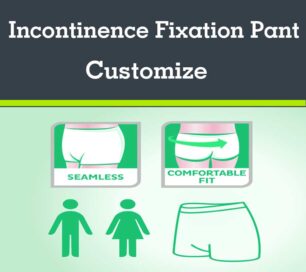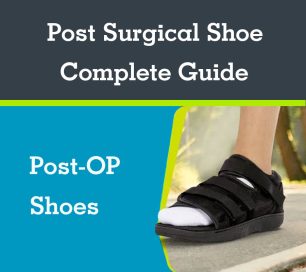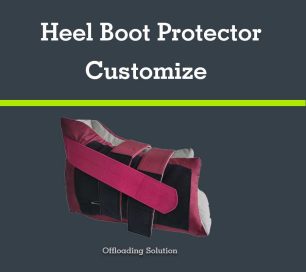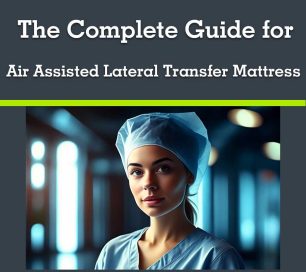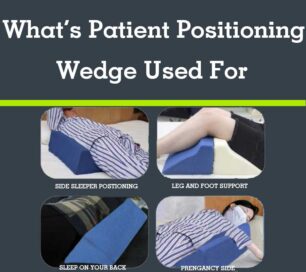Last Updated on 7 months by admin
A good night’s sleep can feel especially elusive when you have incontinence concerns.
Secondly:
- Achieve full protection for your mattresses and furniture;
- Feel secure and enjoy peace of mind throughout day and night;
Incontinence Bed Pad solution OEM customized service
Incontinence: Tips and Advice
Adult Incontinence
If you or a loved one is experiencing nocturnal enuresis, or bedwetting, it can be extremely embarrassing and difficult to deal with. While some people use protective undergarments, such as disposable underwear or plastic pants, others choose not to do so. Regardless, if you or someone you know is experiencing nighttime incontinence, it is important that your mattress/underpads is protected.
To protect your mattress from adult bedwetting, shop for a waterproof mattress protector, such as a mattress cover, mattress pad, or mattress encasement. When selecting a product, keep in mind:
- Ease of Cleaning – Vinyl covers are wiped clean with soap and water, while urethane bed covers and mattress pads are machine washed and dried. Most mattress pads take several cycles to dry thoroughly.
- Frequency of Changing – Fitted covers are put on the mattress/underpad like a fitted sheet while encasements zip around the entire mattress and may require assistance to get in place.
- Comfort – Urethane covers are breathable, and thus the most comfortable. Vinyl is more economical, but it does not breathe and or allow heat transfer.
For frequent urination at night, you may want to invest in some mattress overlay pads (underpads). These small pads lie on top of the sheets and are easy to clean and replace. They protect not only the bed but the bottom sheet. Choose from washable underpads or disposable underpads.
For Adults’ Confidence
Stay dry and sleep soundly with our washable underpads, offering peace of mind for adults managing urinary incontinence.
From frequent wake-ups to needing to change your sheets — incontinence pads are one solution that can help you protect your bed linens and mattress. You traditionally place these pads over your sheets to keep fluids from reaching your sheets and mattress.
Childhood Bedwetting
An estimated 5 to 7 million children over five (school-age) suffer from enuresis or bedwetting. While the exact cause of bedwetting is unknown, there are treatments and solutions to help your child deal with this embarrassing and unpleasant issue. Some treatment options include bedwetting alarms or medication. While these treatments can be effective, some parents or children are apprehensive to begin treatment, yet still need solutions to deal with problems as they occur. We offer many bedwetting solutions for you and your child.
A common temporary method for dealing with bedwetting in children is using disposable pants such as pull-ups or diapers. Because they are disposable, the amount of laundry is decreased and the child, sheets, and clothes are kept dry. Absorbency can be a problem for older kids. The cost of more than $400 per year can be a burden for many families.
Another common solution is using vinyl mattress covers. These economical covers protect the mattress with a layer of vinyl that prevents urine absorption. Vinyl covers are easily wiped clean.
Another solution is a waterproof mattress pad. It fits over the mattress like a traditional mattress pad, but a layer of vinyl is sandwiched between layers of absorbent material. This helps prevent mattress penetration and urine overflow. Because of the absorbent material, waterproof mattress pads require a longer drying time.
Small mattress overlay pads are often the best solution for cutting down on laundry while still absorbing urine and protecting the mattress and bed linens. Overlay pads, or underpads, are great for frequent accidents because they go over the fitted sheet and are intended to absorb urine before it reaches the mattress. Mattress underpads are easy to change, and they often wash and dry in one cycle with other laundry. We also offer disposable overlay pads, which can get pricey when used for a long period.
While underpads are the ideal solution for dealing with nocturnal enuresis, be sure you have some kind of full mattress protection as well – such as a vinyl protector or waterproof mattress pad. Some kids move so much in their sleep that they can end up off the pad or the accident is so large that it goes outside the scope of the pad. Waterproof pillow covers are also recommended for children who fully empty their bladder in bed.
For Kid Comfort
Ensure dry nights for your little one with our reusable bedwetting incontinence pads, keeping accidents at bay for a restful sleep.
As a nurse who has cared for patients from a few days old to 100, I’ve also used many incontinence bed products to help my patients stay dry. I’ve used many of the products on this list and ruled out some that did not work as well in terms of protection and skin integrity.
Premium Peace of Mind:
We are committed to providing nights of uninterrupted sleep and undisturbed rest. With our products, you can relax, confident in the knowledge that your sleep will be peaceful and hassle-free.
Our Commitment to Quality:
Ensuring top-notch quality is our priority, guaranteeing that each product meets the highest standards of comfort and durability.
We’ve compiled a list of the best incontinence bed pads and other options to help you sleep better (and drier) at night.
A quick look at top picks
- Discreet: Metacare – Heavy absorbency underpads
- Ulta-absorbent: Metacare Ultrasorbs premium underpads
- Best for larger-area protection: Extra-large waterproof mattress pad
- Reusable, washable bed pads/underpads: Metacare reusable bed pads for incontinence with handles
- Waterproof, reusable bed pads/underpads: Metacare Health essentials reusable underpad
- Best breathable bed pad/underpads: Incontinence washable bed pad
- Best positioning bed pads/underpads: Bed positioning pad with reinforced handles
What exactly are underpads?
Also referred to as bed pads , underpads are absorbent sheets used on furniture, beds, automobile seats or anywhere an added layer of protection is necessary. Available in a variety of sizes and in both reusable and disposable forms, bed pads are a staple of incontinence care in home settings, hospitals, and long-term care facilities. Underpads are also used for a variety of other medical and non-medical purposes ostomy pouch care, feeding tube changes, and wound management to pet training, youth toilet training, and even for home crafting.
COMMON UNDERPAD FEATURES
- Reusable or Disposable:Functionally, there is little difference between reusable and disposable bed pads, however, some prefer the economic advantage of washable bed pads rather than the convenience of disposables.
- Absorbent Core Materials:Disposable underpads consist of an absorbing polymer that turns liquid into an odor-retaining gel. Reusable bed pads use quilted rayon or poly-rayon fabric. Fabric cores are economically and ecologically friendly, however, the moisture-wicking properties of disposable pads are superior;Reusable & Washable incontinence Underpads consist of 4 layers:Soft surface layer / Absorption layer / TPU waterproof layer and Non Slip leakproof backing
- Backing Material:Disposable bed pads are made with a plastic backing which may make them predisposed to slipping. Some versions have adhesive strips to keep the pad in place. Reusable bed pads have a fabric backing that will be quieter and stay in place.
- Size:Underpad sizing varies from manufacturer to manufacturer but generally range from 17 x 24 inches up to 40 by 57 inches. Larger bed pads are used for mattress coverage and smaller pads are most effective on chairs and other furniture. Multiple pads can be used for full coverage.
- Airflow:Several forms of underpads are available to accommodate special requirements for bedridden or physically inactive individuals as well as those who use low-air loss mattresses or airflow therapy beds. Airflow underpads and air-permeable bed pads are designed to minimize heat and moisture build-up.
- Strength:Some incontinence underpads not only protect surfaces but also act as a multipurpose patient positioning sheet(such as they may with 4-8 Reinforced handles). Usually of the reusable variety, these bed pads come in a variety of strengths accommodating patients up to approximately 400 pounds and often include handles for easy gripping.
- Layering Techniques:Dressing a bed for incontinence will depend on the patient’s absorbency needs and incontinence level. a. Begin with a waterproof mattress cover directly on top of your mattress or over your existing fabric mattress pad for added comfort; b. Add bed pads as follows: 1 to 3 for light or moderate incontinence and 3 or more in an overlapped fashion for heavier incontinence; c. Cover all layers with standard fitted bed sheets. For those suffering from heavy incontinence or for those who do not wish to experience moisture on the sheets, add another layer of bed pads on top of the standard sheet.
Reusable Washable Underpads For Incontinence with(out) 8 handles
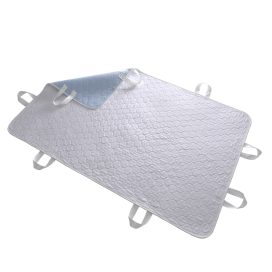
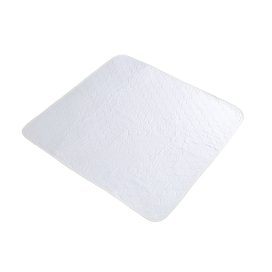
PROTECTING A BED FROM INCONTINENCE OVERFLOW – Troubleshooting
My bed pad keeps slipping out of place.
If your bed pad keeps slipping off, securing it in place by putting it underneath the fitted sheet can help. You can also use a zippered fitted sheet to prevent the bed pad from moving around or try bed pads with adhesive strips.
The underpad is making my bed too warm.
If you find your bed pad makes your bed feel too warm and uncomfortable, you should try using a breathable bed pad. These moisture-wicking bed pads are extremely helpful in regulating the temperature in your bed by utilizing airflow to prevent the accumulation of heat and sweat.
The bed pad is noisy or uncomfortable.
Bed pads with a plastic layer can make a squeaking noise. If you find this uncomfortable to sleep through, try a bed pad with a soft top sheet. The soft layer on top will feel much more comfortable and it will not make any noise as you move around.
When and why to use incontinence bed pads/Underpads
You can use incontinence bed pads any time you’re worried your bed linens may be soiled due to incontinence (urine or stool) or bleeding. Some examples include:
- For a child who has frequent bedwetting episodes.
- After a surgical procedure, like a prostatectomyTrusted Source.
- In the recovery period after childbirthTrusted Source.
- For a loved one who has periods of bladder or bowel incontinence.
There are a number of conditions, including dementia and post-stroke, that can result in incontinence. Using incontinence bed pads can help keep linens clean.
Some are washable while others are disposable. What’s most important is that you choose a bed pad that protects your skin and linens.
How we chose incontinence bed pads
We kept in mind that pads may be used for urinary or bowel issues and looked for a mix of disposable and washable options to enable you to pick the one you most prefer. We took into account factors like:
- absorption
- material comfort (for example, smoother and softer surfaces are better for skin integrity)
- size
- components
- construction when selecting the best options
We scoured medical supply sites and some of the country’s largest retailers to identify the best incontinence bed pad options.
As a nurse, I’ve used many of the products that made the list, and I was able to rule out some that didn’t work as well for protecting bedding or skin.
Metacare’s picks for incontinence pads and liners
Deluxe Fluff/Polymer Underpad
When I worked in a busy intensive care unit, these disposable pads were always our top choice for those who were bed-bound and had thin skin or pressure ulcer concerns. These pads are super-soft, so they’re less likely to cause friction and shear injuries.
In addition to the soft benefits, they’re very absorbent. I also like that they’re pre-folded, which makes it easy to stash a few in your suitcase when you’re traveling. If I can say one drawback, it’s that those who toss and turn end up with some of the soft “fluff” on their backside. So if you’re a restless sleeper, you may want to check out the next option in the odor-reducing category.
Ultrasorbs premium underpads
These disposable, ultra-absorbent pads were what the nursing team at my hospital affectionately called “the good pads.” They’re soft, ultra-thin, and have a backsheet that’s impermeable to liquids. As an added benefit, because they’re so absorbent, they offer odor-controlling properties.
The main drawback for these pads is they’re slightly smaller than some other pads. Most of the sizes I reviewed were 36 by 36 inches. But these are 23 by 36. If you need a larger-sized pad, consider some I recommend in the oversized category.
Extra-large waterproof mattress pad
If you’re constantly tossing and turning in bed, finding a protective pad that spans most of your bed can prove difficult. This mattress pad comes in an extra-large size of 34 by 54 inches (a queen-size mattress is usually about 60 inches in width).
As an additional advantage, the darker color is less likely to show stains than some of the lighter-color pad alternatives. This can serve as an advantage because you’ll likely need to frequently wash and re-use the pad.
Reusable bed pads for incontinence
his washable, super-absorbent bed pad can hold up to 8 cups of fluid. When I was reviewing all the options, this pad was the best all-around option because it was absorbent, oversized (34 by 52 inches), and built to withstand 300 or more washes.
The pad features four layers, with the bottom layer having an anti-skid barrier to keep the pad in place as you sleep. The soft, top-most surface is also skin-friendly.
Metacare Health essentials reusable underpad
This machine-washable, waterproof pad has PVC/TPU backing to offer protection for your mattress and sheets. What’s also great about this pad in particular is the PVC/TPU backing, which helps to make the pad non-slip.
The darker pattern will also help to conceal stains until you wash the pad. Its soft, quilted material will be skin-friendly (an added bonus).
Best breathable/washable bed pad
If you always wake up sweating or need to use all-natural materials, this bed pad is an excellent option. While many bed pads are made with artificial fibers (like polyester or PVC), this option is made with cotton and bamboo.
The pad is made to be used on either side. So if it’s summer and you’re feeling the heat, switching the pad to the bamboo side may help you stay cooler.
Using natural fibers doesn’t mean you sacrifice absorption. According to the pad’s manufacturers, the absorptivity is up to 1 liter of fluid (that’s quite a bit). At 39 by 55 inches, it’s also a larger size. The main drawback is the pad is a little pricier than many washable options, but if it keeps you more comfortable, it could be worth the price increase.
Bed positioning pad with reinforced handles
If your loved one requires total care, a positioning bed pad features handles to hold onto so you can assist your loved one in turning, pulling up in the bed, or for transfers from the bed to a wheelchair or stretcher. This positioning pad features 14 reinforced handles and is strong enough for re-positioning and absorbent enough to serve as an incontinence protective pad.
The pad can help you transfer a person up to 400 pounds and is made to withstand frequent washings.
Alternatives to incontinence bed pads
An incontinence pad isn’t the only option for protecting your bed and keeping you dry. Other options include:
- Wearable pads. There are pads that fit in your underwear and are designed specifically for incontinence, like these options by Depend for Men.
- Incontinence underwear. The brief itself is made from absorbent fabric
- Waterproof mattress covers. There are water-repellant mattress covers designed like a fitted sheet. Or there are covers that fully enclose the mattress to repel moisture
- Disposable fitted sheets. These PEELAWAYS fitted sheets are disposable and cover the entire bed. You can peel away the top fitted sheet layer to reveal another bed pad. The main catch with these is they’re only made for twin XL sizes, so you must have a bed that specifically fits this option.
Tips for placing incontinence pads and changing sheets
When I was working as a bedside nurse, incontinence bed pads were something we put on all the beds over draw sheets (folded sheets we use to help pull up or turn a patient in bed). The biggest issues I saw with these pads, also called underbed pads, was their constant migration up to the upper or middle back — and not where you needed them to be, which is under the buttocks.
To combat this, I recommend:
Placing the pad in a lower position in the bed. It usually only goes higher, not lower.
Making an effort to pull the pad back down any time you or your loved one gets up.
Doubling up on pads, if needed, to facilitate future bed changes. For example, if you know you’re likely going to have an overnight accident, going ahead and placing two pads means you can remove and dispose of the top one, and you have another ready to go.
Placing one pad in the horizontal position and the other vertically. This positioning can be a “catch-all” for any messes.
Tips on changing used pads and sheets when the bed is occupied
If you’re changing pads for a loved one who’s bed-bound or has difficulty with transfers, you can also use some nursing tricks to replace the pad or linens without having your loved one get out of bed.
For example, if you’re changing a pad or sheets:
- Turn your loved one to one side of the bed.
- Roll up the pad/sheet halfway until it’s rolled along the length of your loved one, slightly tucked underneath them.
- Placing the clean, new pad halfway on the bed, roll the pad to meet the part under your loved one. For example, if your loved one is turned on to the left side of the bed, the new pad will be flat on the right side of the bed with its other half rolled up behind your loved one.
- Turn your loved one over the rolled edges of both pads on to their other side and the clean pad.
Finish rolling up the dirty pad/sheet and remove the dirty pad and any other dirty linens.
Continue unrolling the clean pad/ putting the clean sheets in place.
This method is helpful for those who can’t get out of bed easily because they can have clean sheets without having to get up often.
Things to keep in mind when choosing pads
Here are some of the major decisions when it comes to incontinence pad purchases:
- Cost: Washable pads are usually going to be the cost-friendly option. But you’ll usually need at least two to switch out and keep clean.
- Earth-friendly: Washable pads create less trash, making them a friendlier option if you’re trying to create less waste.
- Convenience: It’s hard to beat the convenience of disposable pads. You can quickly eliminate the odor by disposing the pad.
- Time: You’ll spend more time washing and drying pads than throwing away single-use options. If you’re a caregiver or have mobility issues, this can make disposable pads an appealing option.
If you opt for disposable pads, you’ll need to make sure you keep up with your ordering. Many companies will offer discounts if you set up a recurring order, which can help you save money.
OEM customized Service – washable incontinence bed pad
Metacare is a trusted manufacturer, supplier, and factory of high-quality incontinence bed pads. Our products are specially designed to provide the best possible protection for patients who are experiencing incontinence. Made with high-absorbent materials, our bed pads are not only comfortable but also reliable and effective.
Our incontinence bed pads are suitable for all kinds of situations, including nursing homes, hospitals, and even for home-based care. These pads come in various sizes, making it easy to find the right fit for different beds and patients. The thick absorbent core guarantees that these bed pads will keep your bed dry and free from unpleasant smells despite heavy usage.
When it comes to senior care, maintaining hygiene and cleanliness is not only important but also a mandatory requirement. With Metacare’s incontinence bed pads, you can rest assured that your loved ones will be cared for with comfort and dignity. Contact us today to learn more about our products and how we can help meet your incontinence care needs.
The takeaway
Incontinence bed pads can be one of several strategies you can utilize to protect your bed and sheets if you experience episodes of incontinence. You can use these pads alone or in combination with other incontinence products to help you or a loved one.
FAQ:
How do I use incontinence bed pads?
Incontinence mattress pads are useful as an extra layer of protection to prevent urine or fecal matter from reaching bedding. There are several types of bed pads for incontinence. Absorbent bed pads can be spread atop bedding to protect both the sheets and the mattress. Incontinence bed sheets are another product useful to protect mattresses that are not waterproof.
Alternatively, waterproof mattress covers and bed pads are designed to be placed on the mattress directly. They work by preventing moisture from seeping through to the mattress itself. Instead of needing to deep clean the mattress, waterproof mattress covers can be wiped clean and sanitized.
How do I wash and dry incontinence bed pads?
Disposable bed pads are popular because there is no need to launder them. However, reusable underpads can save money. Washing reusable underpads is usually no more difficult than your average load of laundry. You may not want to wash them with the rest of the household’s laundry, however. Follow the manufacturer’s care instructions for detergent, wash and dry cycles, and fabric softener.
Also be aware that tumble drying can take a long time and be costly for bulky underpads. If you have access to a clothesline or another way to air dry mattress pads, you are free to air dry them.
How many incontinence pads should be placed on the bed?
1 to 2 underpads per day for light to mild incontinence. 2 to 4 underpads per day for moderate incontinence. 4 to 6 underpads per day for heavy incontinence.
How do you keep Underpads in place?
Some people find success using bed pad holders or grippers, which are designed to keep pads from moving around. Alternatively, consider purchasing bed pads with adhesive strips, like those offered by Wuhan Youfu, for a no-fuss solution to keeping the pads in place.
Do incontinence pads go under the sheet?
From frequent wake-ups to needing to change your sheets — incontinence pads are one solution that can help you protect your bed linens and mattress. You traditionally place these pads over your sheets to keep fluids from reaching your sheets and mattress.
What pad holds the most urine?
Hybrid Pads hold a maximum of 135ml (9 tbsp) of liquid. Each Moderate pad holds a maximum of 245ml (1 cup) of liquid. Each Heavy pad holds a maximum of 435ml (1.8 cups) of liquid. Each Heavy Plus pad holds a maximum of 540ml (2.2 cups) of liquid.
What is the disadvantage of using an incontinence pad?
Incontinence pads are typically bulky and thick, making them uncomfortable to wear for long periods. Discomfort can be especially troublesome for people suffering from skin conditions such as eczema or psoriasis.
Do incontinence pads hold a full bladder?
Incontinence pads may be helpful but sometimes get in the way complicating or hampering the process of passing urine for people with some disabilities. Unfortunately, pads, even when very absorbent, cannot accommodate emptying a full bladder (e.g. 1 pint/0.5 litre) all at once.
What can I put on my bed for incontinence?
For frequent urination at night, you may want to invest in some mattress overlay pads (underpads). These small pads lie on top of the sheets and are easy to clean and replace. They protect not only the bed but the bottom sheet. Choose from washable underpads or disposable underpads.
how to stop your continence pad from leaking?
Some continence products have adhesive (sticky) strips so that the pad doesn’t slip and is kept in place in underwear or mesh pants.
“Channelling” a new pad is another way to get a better fit. Metacare demonstrated how to unpack and get an all-in-one pad ready for use.
How do I decrease my laundry load?
Laundry is always a concern for families with bedwetting problems. From sheets to blankets to sleeping bags, laundry is often a daily activity. The easiest way to decrease the laundry load is by using overlay pads, also known as underpads. They go over the fitted sheet and absorb moisture before it has a chance to get to the sheets and mattress. We offer disposable or reusable pads to fit your needs. The disposable pads are removed and thrown away while the reusable pads can be thrown in with other laundry and do not require their own cycle. If your child is using a sleeping bag, we also offer sleeping bag liners which can fit in standard washing machines. Don’t forget these easy solutions to decrease your laundry load!
How do I protect my bed from incontinence?
The answer to this question varies depending on the level and type of incontinence. To ensure complete protection, a combination of incontinence aids like protective underwear or bladder control pads and underpads is most effective. For mild urinary incontinence with occasional leaks and drips, a disposable underpad on top of your mattress pad is effective. For bedridden patients or patients with severe urinary incontinence, you may want to pair bed pads with a waterproof mattress protector to avoid costly replacement.
Fecal incontinence will require some extra measures. Disposable bed pads or reusable hospital bed pads are best used atop sheets to help protect them and to make laundering easier. Beneath the sheets, make sure to use a waterproof mattress cover to prevent fecal matter from coming into contact with the mattress.
Can I use an underpad with a waterproof mattress cover?
Yes, you can pair an underpad with a waterproof hospital mattress cover. In fact, in some cases, this may be the preferable way to protect the bed. Underpads are designed with absorbent material, and many feature waterproof back covers to prevent moisture from reaching the bed. This is especially true if incontinence is severe or happens overnight when you may not wake to change the underpad. In these cases, pair an underpad with a waterproof bed pad to make sure that liquid and fecal matter can’t reach the mattress.
What are some alternative uses for underpads?
Underpads and hospital bed pads don’t always have to be used on beds. In fact, they can be used in a number of different ways to protect surfaces. Place them on chairs or sofas to prevent leaks from reaching the upholstery. Use them to cover carpet if you are working around the house and anticipating a spill. They can be used to protect wheelchair seats, too. Some people have even used underpads to paper train pets or as temporary doormats.

